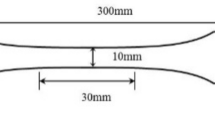Abstract
In this paper, a high-temperature test experimental system is built to investigate the dependence of the strength of a C/SiC composite material on temperature. Unintuitively, the strength increases with temperature. To investigate the microscopic mechanism, scanning electron microscopy (SEM) of an in situ bending test experiment is performed. Our hypothesis is that due to significant residual tensile stress in inter-fibre matrix, external loads reach the ultimate stress first. As the temperature increases, the matrix residual tensile stress decreases, a larger external load needs to be applied for matrix failure, which is exhibited macroscopically as increased strength. To prove this hypothesis, the inter-fibre matrix residual stress and its dependence on temperature are calculated via a finite element method. Next, using a SiC wrapper layer around a single C fibre as an experiment object, the finite element calculation is verified directly via micro-Raman spectroscopy.










Similar content being viewed by others
References
Yang, Y., Xu, F., Gao, X., et al.: Impact resistance of 2D plain-woven C/SiC composites at high temperature. Mater. Des. 90, 635–641 (2016)
Choury, J.J., Thermostructural composite materials: Fabrication and main applications.In: proceedings of the 4th international symposium on ceramic materials and components for engines. In: Chapman and Hall London: 102–112 (1992)
Heraud, L., Spriet, P.: High toughness C/SiC and SiC/SiC composites in heat engines, Whisker- Fiber-Toughened Ceram, pp. 217–224 (1988)
Feldhoff, A., Pippel, E., Woltersdorf, J.: Interface engineering of carbon fiber reinforced Mg–Al alloys. Adv. Eng. Mater. 2(8), 471–480 (2000)
Pimenta, S., Pinho, S.T.: Recycling carbon fibre reinforced polymers for structural applications: technology review and market outlook. Waste Manag. 31, 378–392 (2011)
Engesser J M. Monotonic, creep-rupture, and fatigue behavior of carbon fiber reinforced silicon carbide (C/SIC) at an elevated temperature [J]. 2004
Luan, X., Cheng, L., Xie, C.: Stressed oxidation life predication of 3D C/SiC composites in a combustion wind tunnel[J]. Compos. Sci. Technol. 88, 178–183 (2013)
Cao, X., Yin, X., Fan, X., et al.: High-temperature flexural properties of SiBC modified C/SiC composites [J]. Ceram. Int. 40(4), 6185–6190 (2014)
Yang, C.P., Zhang, L., Wang, B., et al.: Tensile behavior of 2D-C/SiC composites at elevated temperatures: experiment and modelling [J]. J. Eur. Ceram. Soc. (2016)
Patel, M., Kiran, M.P.S., Kumari, S., et al.: Effect of oxidation and residual stress on mechanical properties of SiC seal coated C/SiC composite [J]. Ceram. Int. 44(2), 1633–1640 (2018)
Wolf, I.D., Maes, H.E., Jones, S.K.: Stress measurements in silicon devices through Raman spectroscopy: Bridging the gap between theory and experiment [J]. J. Appl. Phys. 79(9), 7148–7156 (1996)
Young, R.J., Huang, Y.L., Gu, X., et al.: Analysis of composite test methods using Raman spectroscopy. Plastics, Rubber & Composites Processing and Appl. (23), 11–19 (1995)
Wolf, I.D., Jian, C., Spengen, W.M.V.: The investigation of microsystems using Raman spectroscopy [J]. Opt Lasers Eng. 36(2), 213–223 (2001)
Ghosh, D., Subhash, G., Orlovskaya, N.: Measurement of scratch-induced residual stress within SiC grains in ZrB2–SiC composite using micro-Raman spectroscopy [J]. Acta Mater. 56(18), 5345–5354 (2008)
Liu, X., Liu, Y., Jin, B., et al.: Microstructure evolution and mechanical properties of a smated mg alloy under in situ SEM tensile testing [J]. J Mater Sci Technol. 33(3), 224–230 (2017)
Zhang, L.T.: Fiber-reinforced silicon carbide ceramic composites: modelling, characterization and design. Chemical Industry Press, Beijing (2009)
Li, Z., Bradt, R.C.: Thermal expansion of the cubic (3C) polytype of SiC. J. Mater. Sci. 21, 4366–4368 (1986)
Li, Z., Bradt, R.C.: The single crystal elastic constant of cubic (3C) SiC to 1000 °C. J. Mater. Sci. 22, 2257–2259 (1987)
Acknowledgements
The authors appreciate sponsorship from the National Natural Science Foundation of China (11672340) for supporting this research. In addition, the authors declare that no conflict of interest exists in the submission of this manuscript.
Author information
Authors and Affiliations
Corresponding author
Additional information
Publisher’s Note
Springer Nature remains neutral with regard to jurisdictional claims in published maps and institutional affiliations.
Rights and permissions
About this article
Cite this article
Su, F., Huang, P. Microscopic Mechanism of the High-Temperature Strength Behaviour of a C/SiC Composite. Appl Compos Mater 26, 1059–1071 (2019). https://doi.org/10.1007/s10443-019-09766-6
Received:
Accepted:
Published:
Issue Date:
DOI: https://doi.org/10.1007/s10443-019-09766-6




